The Samsung Galaxy S7 and S7 edge Review: Part 2
by Joshua Ho on July 5, 2016 8:00 AM ESTCamera Architecture and UX
In general, camera has become probably the single biggest point of differentiation between smartphones at this point. As smartphones are often the only camera that most people carry on a day to day basis, the rear camera on a smartphone really cannot be a disappointment relative to the competition. While we can talk about how much a front-facing camera matters in terms of quality, it’s pretty safe to say that for photos and videos that are worth saving will be taken with the rear-facing camera.
While post-processing and a number of other factors are going to have a huge impact on the overall camera experience, the foundation that makes it possible to deliver a great camera is always going to start at the hardware.
| Samsung Galaxy S Cameras | ||||
| Galaxy S6 Galaxy Note5 |
Galaxy S7 | |||
| Front Camera | 5.0MP | 5.0MP | ||
| Front Camera - Sensor | Samsung S5K4E6 (1.34 µm, 1/4.1") |
Samsung S5K4E6 (1.34 µm, 1/4.1") |
||
| Front Camera - Focal Length | 2.2mm (22mm eff) | 2.1mm (21mm eff) | ||
| Front Camera - Max Aperture | F/1.9 | F/1.7 | ||
| Rear Camera | 16MP | 12MP | ||
| Rear Camera - Sensor | Sony IMX240 Samsung S5K2P2 (1.12 µm, 1/2.6") |
Sony IMX260 Samsung S5K2L1 (1.4 µm, 1/2.6") |
||
| Rear Camera - Focal Length | 4.3mm (28mm eff) | 4.2mm (26mm eff) | ||
| Rear Camera - Max Aperture | F/1.9 | F/1.7 | ||
In the case of the Galaxy S7, Samsung has done something that I thought they’d never do, which is move backwards in resolution in order to improve pixel sensitivity. In the case of the Galaxy S7, Samsung has moved from the Sony IMX240/Samsung S5K2P2 to the Sony IMX260/Samsung S5K2L1 sensor, with a 1.4 micron pixel size relative to a 1.12 micron pixel pitch in the previous generation. This means that there’s a 56% increase in sensitivity per pixel. Assuming the same process technology, this does improve low light performance significantly. While to some extent it’s true that improved CIS (CMOS image sensor) technology can alleviate the downsides of smaller pixels, on the same technology you have to reduce your fill factor/active sensor area. The other problem is that while read noise on the sensor does reduce per pixel as you reduce pixel size, the overall sensor read noise trends upwards. This means that the region in which the CIS noise is primarily limited by shot noise is going to be smaller as you reduce pixel size. Shot noise is an unavoidable reality of existence, to the extent that even our eyes can see this “visual snow” if ambient light is sufficiently dim.
However, in the case of the Galaxy S7 I suspect that there’s more to the story, because the dual pixel AF system means that for each 1.4 micron pixel each pixel needs two photodetectors. In order to make phase detection work, there has to be sufficient spatial separation to make this system work properly, so some of the benefit of these larger pixels will inevitably be eaten up in order to enable PDAF that works in basically all lighting conditions.
The other notable change here is that the Galaxy S7 uses an even wider f/1.7 aperture. Unfortunately, in Samsung's efforts to try and make the module thinner they've made the focal length slightly shorter than before which results in an effective focal length of 26mm. This and the wider aperture could lead to compromises as light is entering the optics at a more extreme angle than before.
With these basics covered, we can move on to a discussion of the user experience. While in the past it was easy enough to just take some still shots on a tripod, a holistic view of camera quality really needs to take into account far more than just the end result. A poorly designed camera application with low resolution, low frame rate preview, improper preview aspect ratio, poor control layout, and other issues can easily make it difficult, if not impossible to get the photo that you want. These issues are thankfully getting less common, but these problems can make it almost impossible to recommend a phone for its camera, no matter how good the results are.
In the case of the Galaxy S7, the camera application is a nice upgrade over the Galaxy S6 at launch, but for the most part nothing is really different this go around. I’m not going to spend too much time here, but the short story is that I don’t think that Samsung is doing anything wrong here, and things are pretty much as good as they’re going to get.
While leaving it at that would be enough, I want to recognize some of the improvements that Samsung has implemented here. The major improvement here is that Pro mode is finally useful, as this mode now allows for adjusting auto-exposure and AF targets, in addition to EV, shutter speed, ISO, white balance with 100K granularity, and manual focus. The one notable shortfall here is that Samsung only allows 800 ISO max in manual ISO mode when the true maximum is 1250. For better or worse though, that’s the only notable problem I encountered with the camera app itself. It’s easy to think that Samsung hasn’t done anything notable here, but this is more a testament to the execution of design more than anything else.
However, before we move on to image quality testing, we can take a look at our focus and capture latency tests. For those that are unfamiliar, this is a fairly simple test designed to see how long it takes for a phone to focus and capture a scene on our standard ISO test chart in good lighting conditions, which can give a fairly good idea for best case latencies.
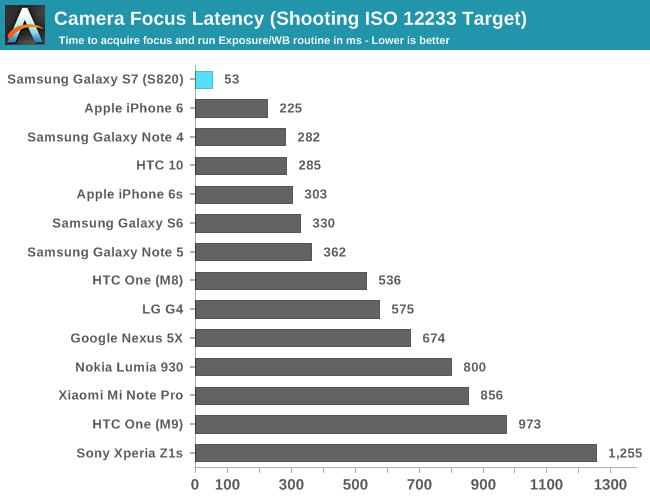
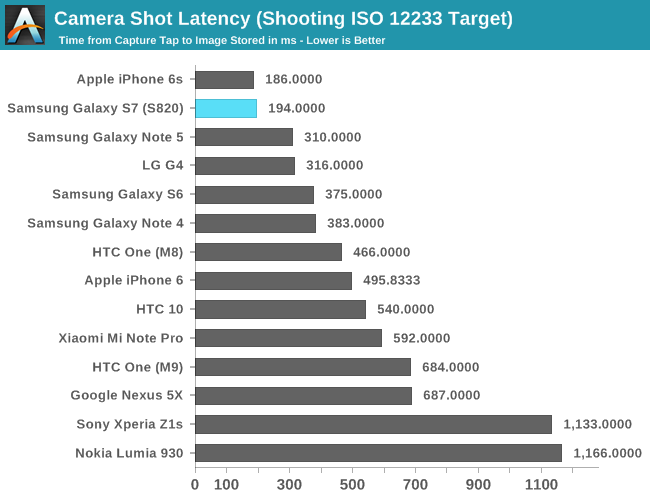
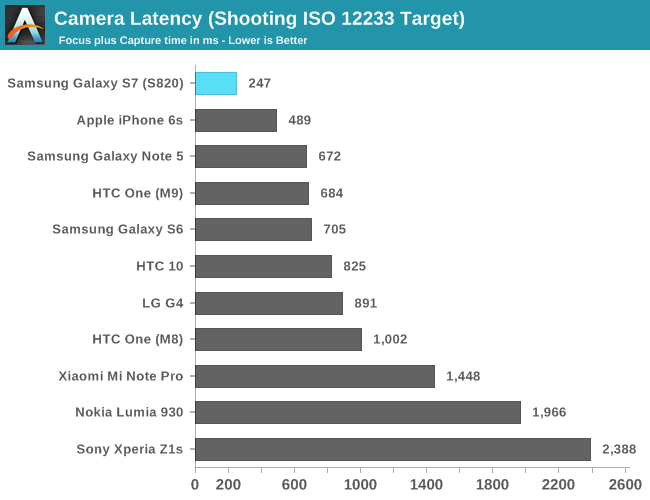
It’s probably not a surprise, but the Galaxy S7 is really, absurdly quick to take photos and focus. There is nothing out there that can realistically match the dual pixel AF system in the Galaxy S7, especially once you get into low light scenarios where traditional PDAF systems are overwhelmed by noise that can’t be easily canceled out. Samsung’s sheer prowess in semiconductor design and manufacture is really showing here, even in the best case.


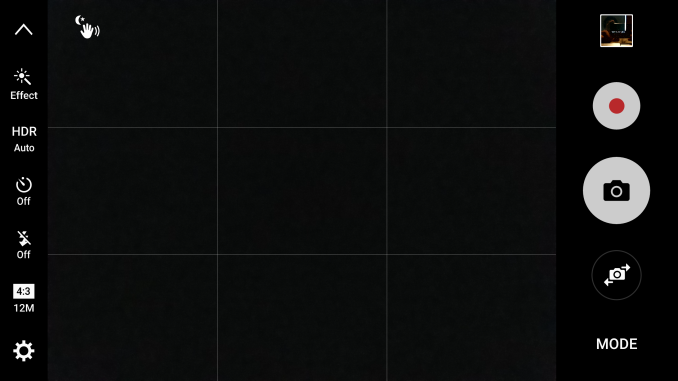
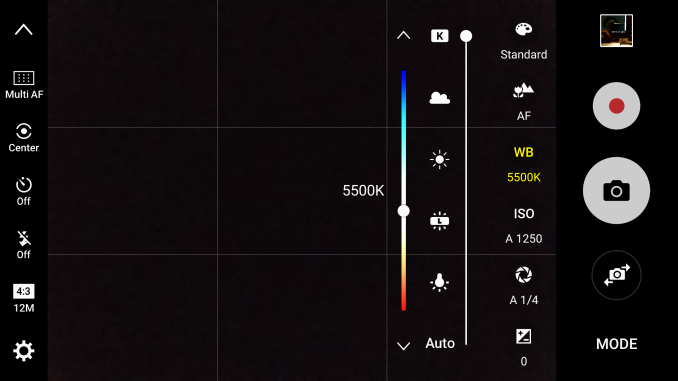
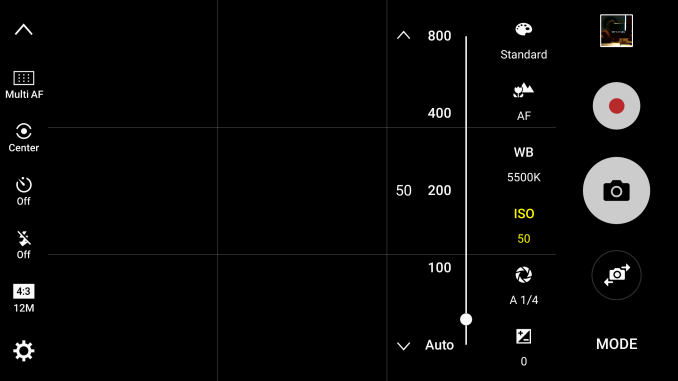








266 Comments
View All Comments
OscarK - Tuesday, July 5, 2016 - link
This is a great article Joshua. It's strange that people would complain, thinking that it is bias simply because you stated the truth and didn't blindly praise it's camera like other reviewers whom somehow have become the embodiment of the likes of Steve McCurry. They might as well say it's bias towards the g5 which you stated is a better still camera (maybe they have some enmity with apple. I don't know). I for one like properly exposed natural photos. I will be getting the one plus 3 though. Loved the review on it.barn25 - Tuesday, July 5, 2016 - link
I don't know how you all wasnt able to test the 8890 version when pretty much all variants of it support almost all US LTE bands.Andrei Frumusanu - Wednesday, July 6, 2016 - link
Because I have that unit and I'm on a different continent and I can't achieve good signal conditions to be able to do a apples to apples comparison to other devices. I'll do 820 vs 8890 comparisons under my network but the values will not be representative to other devices.SunnyNW - Thursday, July 7, 2016 - link
Just a question...but could you guys realistically not ship it back and forth within the four months or so that it took for this review?Jodiuh - Tuesday, July 5, 2016 - link
I usually never post about this and I OWN an iPhone, but FOUR MONTHS for a review when you guys only took one week for the last iPhone?I don't know what has happened to this site, but it seems to take forever to get reviews out now if we even get them.
And it's not just cell phones, there's still no 1080/1070/480 reviews either.
:-(
DCide - Tuesday, July 5, 2016 - link
"... as soon as I start looking closer at everything I start to see cases where Samsung just doesn’t seem to care enough. Everything about the phone seems to be targeted towards being a great experience for the first week or two of ownership ..."Spot on! This is exactly how I've seen Samsung mobile devices for a number of years now - I've just never seen it in print before!
This is exactly why I ultimately exclude Samsung from consideration whenever shopping for an Android device.
TheITS - Tuesday, July 5, 2016 - link
This review managed to find only metrics in which the S7 can be directly compared to every other phone and then tells us that the phone as a whole is average. Where is the testing of the unique features it brings to the table like VR and water resistance? The camera is so fast why isn't there a comparison to see if it can capture lifes more transient moments than the rest of the phone market? People want to know whether it's a phone worth buying and living so please next time explore everything the phone can do and not just where it overlaps.I can see that there is a lot of content in the review but it's a shame that the reviewer doesn't seem to have identified what Samsung were trying to do as a whole with the total experience and whether they hit the mark.
theduckofdeath - Tuesday, July 5, 2016 - link
That is unfortunately what Anandtech has been about for about a decade.raptormissle - Tuesday, July 5, 2016 - link
Takes 3 months to review an Android phone yet iPhones get the red carpet treatment around here at anandtech. The old boss must be still calling the shots. Even mechanical keyboards have a higher priority around here.watzupken - Tuesday, July 5, 2016 - link
"The Galaxy S7 is clearly packed with features and ticks all the right boxes, but as soon as I start looking closer at everything I start to see cases where Samsung just doesn’t seem to care enough. Everything about the phone seems to be targeted towards being a great experience for the first week or two of ownership"Despite the review turning up very late, i.e. at least 4 months late, I still appreciate the objective reviews from the site. I have to agree what is mentioned in the conclusion based on my experience with Samsung products over the years. I was actually contemplating to try out the S7 to see if anything changed, but I think I will skip it.
One honest feedback to folks at Anandtech: Objective reviews are highly appreciated, but they need to be fast as well. Using this article as example, 4 months into the product launch means most people have purchased the product, which greatly diminishes the value of the review.
Thank you folks.